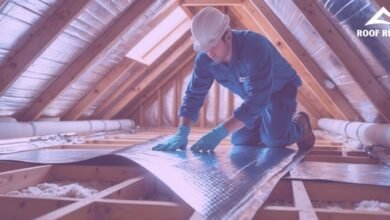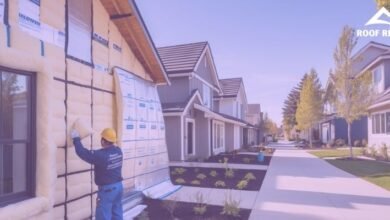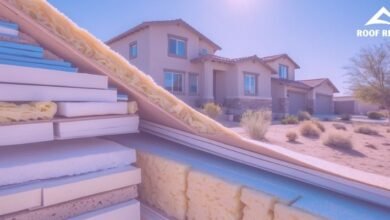How Much Does A New Roof Cost? [2025]: Comprehensive Price Guide for Homeowners
![How Much Does A New Roof Cost? [2025]: Comprehensive Price Guide for Homeowners](https://roofreads.com/wp-content/uploads/2025/06/Experts-Warn-of-U.S.-Food-Safety-Risks-Amid-Federal-Budget-Cuts-20-780x400.jpg)
Thinking about a roof replacement for your home? Understanding the costs involved is important for budgeting this major home improvement project. In 2025, most homeowners can expect to pay between $7,000 and $14,500 for a new roof, with the national average falling around $11,000.
The cost to replace a roof depends on several key factors including your home’s size, roof complexity, and the materials you choose. For a typical 2,000 square foot roof, you might pay between $5.50 and $7.50 per square foot for asphalt shingles, the most common roofing material. Premium options like slate, copper, or solar shingles can push costs well beyond $30,000 for larger or more complex homes.
Asphalt shingles remain the most affordable option, with standard 3-tab composition shingles costing between $5,700 and $12,000 for a complete replacement. Architectural shingles, which offer better durability and appearance, typically cost between $7,500 and $16,000 for an average-sized home.
Key Takeaways
- Most homeowners will spend between $7,000 and $14,500 on a new roof in 2025, with costs varying based on home size and roof design.
- Roofing material significantly impacts price, with asphalt shingles being most affordable and specialty materials like copper or slate costing considerably more.
- The investment in quality roofing materials and professional installation can provide better protection and potentially increase your home’s value.
Understanding New Roof Costs in 2025

Replacing a roof is a major investment that varies based on several important factors. Homeowners can expect to pay between $6,700 and $25,000 for a complete roof replacement in 2025, with most spending around $14,000 for a standard project.
Key Factors Affecting Roof Replacement Cost
The size of your roof significantly impacts the total cost. Roofers measure in “squares” (100 square feet), and a typical 2,000 square foot roof equals 20 squares. Larger roofs require more materials and labor.
Your roof’s complexity also matters. Steep slopes, multiple levels, and features like skylights or chimneys increase labor costs and installation time.
Location plays a crucial role in pricing. Labor rates vary by region, with prices in urban areas typically higher than rural ones. For example, a new roof in Phoenixville, Pennsylvania costs around $7,779, while in West Chester, Pennsylvania, prices range from $4,952 to $13,484.
Other factors include:
- Removal costs of old roofing
- Structural repairs if needed
- Permit fees in your area
- Season when work is performed
Average Cost of a New Roof
In 2025, most homeowners spend between $5,000 and $15,000 for a complete roof replacement. The national average hovers around $14,000 for a 2,000 square foot roof using quality materials.
Basic projects using standard materials might start at $6,700 for smaller homes. More complex installations or premium materials can push costs beyond $30,000 for larger homes.
Labor typically accounts for 60% of the total cost. Prices vary seasonally, with potential discounts available during off-peak times.
Most roofing projects take 1-3 days to complete, though weather and complexity can extend this timeframe.
Cost by Roofing Material
Asphalt shingles remain the most affordable option, costing $2.50-$5.50 per square foot installed. These popular shingles typically last 15-30 years depending on quality.
Metal roofing ranges from $5.50-$14 per square foot and offers 40-70 years of service. Steel and aluminum options fall on the lower end, while copper and zinc premium metals cost significantly more.
Clay or concrete tiles cost $10-$18 per square foot installed. They offer excellent durability (50+ years) but require stronger structural support.
Wood shakes run $6.50-$14 per square foot and provide a natural aesthetic but require more maintenance.
Slate is among the most expensive at $15-$30 per square foot, but can last over 100 years with proper installation and maintenance.
Pricing Details and Key Cost Drivers

When planning for a new roof, understanding the specific factors that affect pricing helps you budget accurately. Several elements combine to determine your final cost, from the physical dimensions of your roof to where your home is located.
Roof Size and Its Impact on Cost
Roof size is the primary factor affecting your total replacement cost. Most roofing professionals calculate costs per square (100 square feet) or per square foot.
For a typical 2,000 square foot residential roof, expect to pay between $10,000 and $15,400 using standard asphalt shingles. This translates to approximately $5.50 to $7.50 per square foot.
A breakdown by common residential roof sizes:
- Small home (1,000-1,500 sq ft): $5,500-$11,250
- Medium home (1,500-2,200 sq ft): $8,250-$16,500
- Large home (2,200-3,000 sq ft): $12,100-$22,500
Remember that roof square footage typically exceeds your home’s floor area due to overhangs, pitch, and design elements.
Labor Costs and Rates in 2025
Labor makes up roughly 60% of your total roof replacement cost. Current 2025 labor rates range from $1.50 to $3.00 per square foot for standard roofing materials.
Factors affecting labor costs include:
- Removal of old roofing: $1-$5 per square foot
- Complexity of installation: Basic to complex designs
- Seasonal demand: Summer typically costs more
- Local market conditions: Urban areas often charge higher rates
Professional installation is crucial despite the cost. Poorly installed roofs lead to leaks, reduced lifespan, and voided warranties.
Most contractors include labor, materials, and cleanup in their quotes. Always request itemized estimates to understand what you’re paying for.
How Roof Pitch and Complexity Affect Pricing
Roof pitch significantly impacts both labor costs and material requirements. Steeper roofs require:
Safety equipment: Additional harnesses and scaffolding add $500-$1,000 to projects on steep roofs.
Slower installation: Workers move more cautiously on steep surfaces, extending labor hours by 25-50%.
More materials: Steep roofs have greater surface area than flat ones with the same footprint.
Complex roof designs with multiple angles, dormers, skylights, or chimneys further increase costs. Each roof penetration requires special flashing and waterproofing, adding $200-$500 per feature.
A simple gable roof might cost $5-$7 per square foot, while a complex roof with multiple pitches could reach $7-$10 per square foot for the same materials.
Regional Differences: Cost by Location
Your location significantly affects roofing costs due to regional variations in:
Labor markets: Expect higher costs in areas with higher costs of living. Metropolitan areas may charge 15-30% more than rural regions.
Building codes: Some locations require specific materials or installation methods to meet local regulations for wind, fire, or weather resistance.
Climate considerations: Areas with extreme weather often need premium materials, increasing costs.
Average regional pricing variations (for standard asphalt shingles):
- Northeast: $6.00-$9.00 per sq. ft.
- Midwest: $5.50-$7.50 per sq. ft.
- South: $5.00-$7.00 per sq. ft.
- West Coast: $6.50-$9.50 per sq. ft.
Local material availability and shipping costs also influence regional pricing differences.
Comparing Roofing Materials and Options
Choosing the right roofing material affects both your budget and your home’s performance. Different materials offer varying lifespans, energy efficiency benefits, and aesthetic appeal at different price points.
Asphalt Shingles vs. Architectural Shingles
Asphalt shingles remain the most popular roofing choice due to their affordability. Standard 3-tab asphalt shingles cost between $3.50 and $5.50 per square foot installed, making them the budget-friendly option.
Architectural shingles provide a more dimensional appearance and typically cost $4.50 to $7.00 per square foot. They offer several advantages over standard asphalt:
- 30-year warranty versus 15-20 years for standard shingles
- Better wind resistance (120-150 mph vs. 60-80 mph)
- More aesthetic options and a higher-end look
While costing about 20-40% more than standard shingles, architectural options deliver better long-term value through extended durability and enhanced curb appeal.
Metal Roofing and Energy Efficiency
Metal roofing has gained popularity for its exceptional durability and energy efficiency. Costs range from $8 to $14 per square foot for aluminum or steel panels.
The energy-saving benefits of metal roofing are substantial:
| Benefit | Details |
|---|---|
| Reflectivity | Reflects up to 70% of solar heat |
| Cooling Savings | Can reduce cooling costs by 15-25% |
| Lifespan | 40-70 years (vs. 15-30 for asphalt) |
Metal roofs require minimal maintenance and can be installed over existing roofs in some cases. Many are made from recycled materials and are 100% recyclable at the end of their life.
The higher upfront investment often pays off through energy savings and reduced replacement needs.
Clay, Concrete, and Tile Roofs
Tile roofing options provide distinctive aesthetics with excellent durability. Clay tiles cost $10 to $18 per square foot installed and offer a classic, southwestern or Mediterranean look.
Concrete tiles provide a more affordable alternative at $8 to $12 per square foot while maintaining similar benefits:
- 50+ year lifespan
- Excellent fire resistance
- Superior insulation properties
- Low maintenance requirements
Both materials require structural reinforcement due to their weight. This adds $1,000-$3,000 to installation costs for homes not originally designed for tile roofing.
Despite higher initial costs, tile roofs often increase property values and provide excellent long-term performance in appropriate climates.
Slate, Wood, and Alternative Materials
Slate roofing represents the premium end of roofing materials, costing $15 to $30 per square foot installed. Its natural beauty and century-plus lifespan make it unmatched for durability.
Wood shingles and shakes (typically cedar) offer a rustic, natural appearance at $8 to $13 per square foot. They require more maintenance and have fire-resistance concerns in some regions.
Alternative options include:
- Solar shingles: $20-$25 per square foot, offering energy generation benefits
- Synthetic slate: $8-$12 per square foot, providing slate’s look at reduced weight and cost
- Composite materials: $7-$10 per square foot, mimicking wood or slate with better durability
Material choice should balance regional climate considerations, home architecture, budget constraints, and long-term value. Quality materials generally provide better returns despite higher initial costs.
Extra Considerations and Value Factors
Beyond basic pricing, several additional factors can significantly impact your roofing project’s overall cost and value. These considerations range from contractor selection to long-term property value benefits.
Roofing Contractors and Installation Quality
Choosing the right roofing contractor is crucial for a successful installation. Professional roofers typically charge between $40-$80 per hour for labor, which represents 40-60% of your total roofing cost.
Experienced contractors may charge more, but often deliver superior workmanship that extends roof life. Always verify contractors have proper licensing, insurance, and positive reviews.
Request at least 3-5 estimates from different contractors to compare pricing. Be wary of unusually low bids, as they might indicate substandard materials or workmanship.
The complexity of your roof design also affects installation costs. Steeper slopes, multiple levels, and unusual angles require more labor hours and safety equipment, potentially increasing costs by 25-40%.
Warranties and Warranty Options
Roofing warranties typically come in two forms: manufacturer warranties covering materials and workmanship warranties from contractors. Material warranties generally range from 20-50 years depending on product quality.
Standard manufacturer warranties cover defects in roofing materials but often don’t include labor costs for repairs. Extended warranties are available at additional cost, typically $1-$4 per square foot.
Workmanship warranties from contractors usually last 2-10 years and protect against installation errors. Premium contractors may offer longer coverage periods of up to 25 years for higher-quality installations.
Read warranty terms carefully before signing. Many warranties have prorated coverage that diminishes over time and may be voided by improper maintenance or unauthorized repairs.
Related Costs: Removal, Gutters, and Repairs
Roof removal costs $1-$5 per square foot depending on existing layers and material types. Most municipalities allow only two layers of roofing, making removal necessary in many replacement cases.
Gutter replacement often coincides with roofing projects, adding $4-$30 per linear foot depending on material. Seamless aluminum gutters cost about $6-$12 per linear foot installed.
Roof inspections ($150-$400) can identify needed repairs before replacement. Minor repairs cost $150-$1,500 depending on issues, while major structural repairs may exceed $7,000.
Unexpected issues like rotted decking can add $2-$4 per square foot to your project. Setting aside 10-20% of your budget for contingencies is recommended to cover these potential surprises.
Home Value, Curb Appeal, and Resale Impact
A new roof typically returns 60-70% of its cost in increased home value. For a $14,000 roof replacement, expect about $8,400-$9,800 in added property value.
Real estate data shows homes with new roofs sell 1-3 weeks faster than comparable properties with aging roofs. This can reduce carrying costs during the selling period.
Roof aesthetics significantly impact curb appeal. Designer shingles or metal roofing can transform a home’s appearance and create a distinctive look that stands out in the neighborhood.
Energy-efficient roofing materials can reduce cooling costs by 15-30%. This ongoing savings, combined with potential insurance discounts of 5-35%, provides additional financial benefits beyond resale value.
Frequently Asked Questions
Roof replacement costs vary based on several key factors including square footage, materials, and location. Understanding these variables helps homeowners budget appropriately for this significant home improvement project.
What are the average costs to replace a roof on a 2,200 square foot house in 2025?
For a 2,200 square foot house in 2025, the average roof replacement cost ranges from $12,100 to $16,500. This estimate is based on the standard calculation of $5.50 to $7.50 per square foot for asphalt shingle roofing, the most common residential roofing material.
Premium materials like metal, slate, or tile would increase this cost significantly, potentially reaching $22,000 to $33,000 for the same square footage.
Can you provide the cost estimates for re-roofing a 1,600 square foot home this year?
Re-roofing a 1,600 square foot home in 2025 typically costs between $8,800 and $12,000 for asphalt shingles. This calculation uses the average price range of $550 to $750 per roofing square (100 square feet).
Homeowners choosing architectural shingles might see costs around $10,400 to $14,400, while basic three-tab shingles could be slightly less expensive.
What factors influence the price of installing a new roof on a 3,000 square foot property?
Roof complexity significantly impacts costs for larger 3,000 square foot properties. Homes with multiple levels, steep slopes, or numerous dormers require more labor and materials, increasing the price by 20-30%.
Existing roof conditions also matter. If the underlying structure needs repairs or the old roofing requires complete removal, costs can increase by $1,000 to $3,000.
Material quality creates substantial price differences. While basic asphalt might cost $16,500 to $22,500 for this size, premium materials like metal or slate could push costs to $30,000-$45,000.
Are there regional cost differences for new roof installations, for instance, the costs in Texas in 2025?
Regional differences significantly impact roofing costs. In Texas for 2025, roof replacement typically costs 5-10% less than the national average due to lower labor costs and milder weather allowing year-round work.
However, coastal Texas areas may see higher prices due to hurricane-resistant requirements and special wind ratings. These specifications can add 15-20% to standard roofing costs.
Urban areas like Dallas or Houston generally have higher labor rates than rural Texas regions, creating price variations of $1-2 per square foot even within the state.
Is there a price difference in roofing materials for a 1,500 square foot home compared to a 2,000 square foot one?
The per-square-foot cost of roofing materials remains relatively consistent regardless of home size. Both 1,500 and 2,000 square foot homes would pay the same $5.50-$7.50 per square foot for asphalt shingles.
However, larger projects may qualify for bulk material discounts. A 2,000 square foot roof might receive a 5-8% discount on materials compared to smaller projects.
Labor efficiency improves with larger, simpler roofs. Contractors often charge slightly less per square foot for larger projects because setup costs are spread across more area.
What is the financially optimal time of year to replace a roof to potentially minimize expenses?
Late fall and winter (November through February) typically offer the best pricing on roof replacements, with potential savings of 5-15%. Roofing contractors experience reduced demand during these months and often lower prices to maintain workflow.
Spring rush periods (March-May) generally have the highest prices as demand surges after winter weather damage becomes apparent. Avoiding this peak season can result in significant savings.
Some roofing companies offer promotional discounts during their slow periods. Scheduling a roof replacement during these promotional windows can save homeowners hundreds or even thousands of dollars.




